Sitan Chen
ReGuidance: A Simple Diffusion Wrapper for Boosting Sample Quality on Hard Inverse Problems
Jun 12, 2025Abstract:There has been a flurry of activity around using pretrained diffusion models as informed data priors for solving inverse problems, and more generally around steering these models using reward models. Training-free methods like diffusion posterior sampling (DPS) and its many variants have offered flexible heuristic algorithms for these tasks, but when the reward is not informative enough, e.g., in hard inverse problems with low signal-to-noise ratio, these techniques veer off the data manifold, failing to produce realistic outputs. In this work, we devise a simple wrapper, ReGuidance, for boosting both the sample realism and reward achieved by these methods. Given a candidate solution $\hat{x}$ produced by an algorithm of the user's choice, we propose inverting the solution by running the unconditional probability flow ODE in reverse starting from $\hat{x}$, and then using the resulting latent as an initialization for DPS. We evaluate our wrapper on hard inverse problems like large box in-painting and super-resolution with high upscaling. Whereas state-of-the-art baselines visibly fail, we find that applying our wrapper on top of these baselines significantly boosts sample quality and measurement consistency. We complement these findings with theory proving that on certain multimodal data distributions, ReGuidance simultaneously boosts the reward and brings the candidate solution closer to the data manifold. To our knowledge, this constitutes the first rigorous algorithmic guarantee for DPS.
Information-Computation Gaps in Quantum Learning via Low-Degree Likelihood
May 28, 2025Abstract:In a variety of physically relevant settings for learning from quantum data, designing protocols that can computationally efficiently extract information remains largely an art, and there are important cases where we believe this to be impossible, that is, where there is an information-computation gap. While there is a large array of tools in the classical literature for giving evidence for average-case hardness of statistical inference problems, the corresponding tools in the quantum literature are far more limited. One such framework in the classical literature, the low-degree method, makes predictions about hardness of inference problems based on the failure of estimators given by low-degree polynomials. In this work, we extend this framework to the quantum setting. We establish a general connection between state designs and low-degree hardness. We use this to obtain the first information-computation gaps for learning Gibbs states of random, sparse, non-local Hamiltonians. We also use it to prove hardness for learning random shallow quantum circuit states in a challenging model where states can be measured in adaptively chosen bases. To our knowledge, the ability to model adaptivity within the low-degree framework was open even in classical settings. In addition, we also obtain a low-degree hardness result for quantum error mitigation against strategies with single-qubit measurements. We define a new quantum generalization of the planted biclique problem and identify the threshold at which this problem becomes computationally hard for protocols that perform local measurements. Interestingly, the complexity landscape for this problem shifts when going from local measurements to more entangled single-copy measurements. We show average-case hardness for the "standard" variant of Learning Stabilizers with Noise and for agnostically learning product states.
S4S: Solving for a Diffusion Model Solver
Feb 24, 2025Abstract:Diffusion models (DMs) create samples from a data distribution by starting from random noise and iteratively solving a reverse-time ordinary differential equation (ODE). Because each step in the iterative solution requires an expensive neural function evaluation (NFE), there has been significant interest in approximately solving these diffusion ODEs with only a few NFEs without modifying the underlying model. However, in the few NFE regime, we observe that tracking the true ODE evolution is fundamentally impossible using traditional ODE solvers. In this work, we propose a new method that learns a good solver for the DM, which we call Solving for the Solver (S4S). S4S directly optimizes a solver to obtain good generation quality by learning to match the output of a strong teacher solver. We evaluate S4S on six different pre-trained DMs, including pixel-space and latent-space DMs for both conditional and unconditional sampling. In all settings, S4S uniformly improves the sample quality relative to traditional ODE solvers. Moreover, our method is lightweight, data-free, and can be plugged in black-box on top of any discretization schedule or architecture to improve performance. Building on top of this, we also propose S4S-Alt, which optimizes both the solver and the discretization schedule. By exploiting the full design space of DM solvers, with 5 NFEs, we achieve an FID of 3.73 on CIFAR10 and 13.26 on MS-COCO, representing a $1.5\times$ improvement over previous training-free ODE methods.
Train for the Worst, Plan for the Best: Understanding Token Ordering in Masked Diffusions
Feb 10, 2025Abstract:In recent years, masked diffusion models (MDMs) have emerged as a promising alternative approach for generative modeling over discrete domains. Compared to autoregressive models (ARMs), MDMs trade off complexity at training time with flexibility at inference time. At training time, they must learn to solve an exponentially large number of infilling problems, but at inference time, they can decode tokens in essentially arbitrary order. In this work, we closely examine these two competing effects. On the training front, we theoretically and empirically demonstrate that MDMs indeed train on computationally intractable subproblems compared to their autoregressive counterparts. On the inference front, we show that a suitable strategy for adaptively choosing the token decoding order significantly enhances the capabilities of MDMs, allowing them to sidestep hard subproblems. On logic puzzles like Sudoku, we show that adaptive inference can boost solving accuracy in pretrained MDMs from $<7$% to $\approx 90$%, even outperforming ARMs with $7\times$ as many parameters and that were explicitly trained via teacher forcing to learn the right order of decoding.
Blink of an eye: a simple theory for feature localization in generative models
Feb 02, 2025Abstract:Large language models (LLMs) can exhibit undesirable and unexpected behavior in the blink of an eye. In a recent Anthropic demo, Claude switched from coding to Googling pictures of Yellowstone, and these sudden shifts in behavior have also been observed in reasoning patterns and jailbreaks. This phenomenon is not unique to autoregressive models: in diffusion models, key features of the final output are decided in narrow ``critical windows'' of the generation process. In this work we develop a simple, unifying theory to explain this phenomenon. We show that it emerges generically as the generation process localizes to a sub-population of the distribution it models. While critical windows have been studied at length in diffusion models, existing theory heavily relies on strong distributional assumptions and the particulars of Gaussian diffusion. In contrast to existing work our theory (1) applies to autoregressive and diffusion models; (2) makes no distributional assumptions; (3) quantitatively improves previous bounds even when specialized to diffusions; and (4) requires basic tools and no stochastic calculus or statistical physics-based machinery. We also identify an intriguing connection to the all-or-nothing phenomenon from statistical inference. Finally, we validate our predictions empirically for LLMs and find that critical windows often coincide with failures in problem solving for various math and reasoning benchmarks.
Adaptivity can help exponentially for shadow tomography
Dec 26, 2024Abstract:In recent years there has been significant interest in understanding the statistical complexity of learning from quantum data under the constraint that one can only make unentangled measurements. While a key challenge in establishing tight lower bounds in this setting is to deal with the fact that the measurements can be chosen in an adaptive fashion, a recurring theme has been that adaptivity offers little advantage over more straightforward, nonadaptive protocols. In this note, we offer a counterpoint to this. We show that for the basic task of shadow tomography, protocols that use adaptively chosen two-copy measurements can be exponentially more sample-efficient than any protocol that uses nonadaptive two-copy measurements.
Gradient dynamics for low-rank fine-tuning beyond kernels
Nov 23, 2024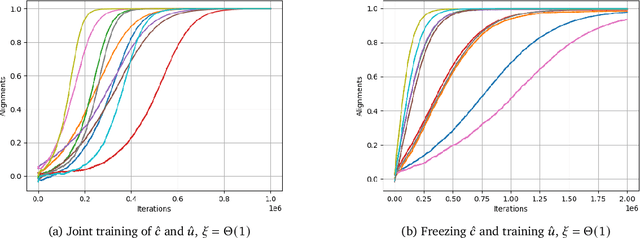
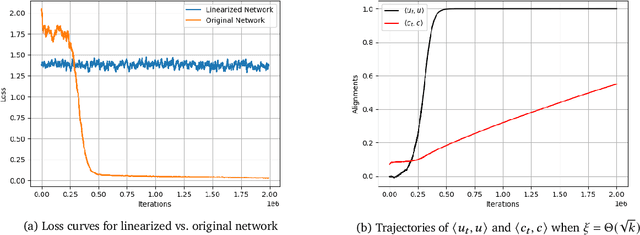
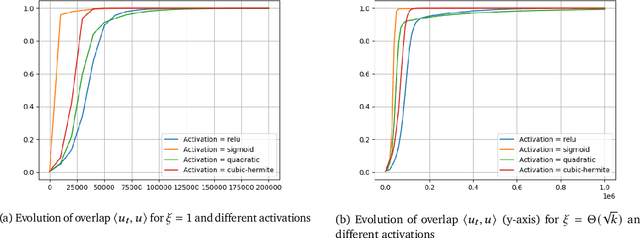
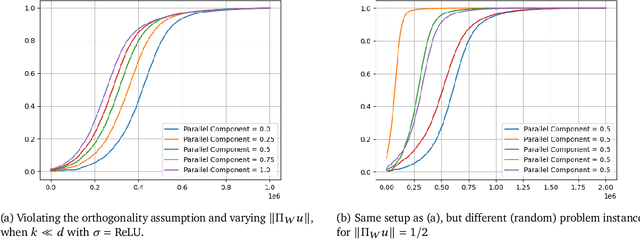
Abstract:LoRA has emerged as one of the de facto methods for fine-tuning foundation models with low computational cost and memory footprint. The idea is to only train a low-rank perturbation to the weights of a pre-trained model, given supervised data for a downstream task. Despite its empirical sucess, from a mathematical perspective it remains poorly understood what learning mechanisms ensure that gradient descent converges to useful low-rank perturbations. In this work we study low-rank fine-tuning in a student-teacher setting. We are given the weights of a two-layer base model $f$, as well as i.i.d. samples $(x,f^*(x))$ where $x$ is Gaussian and $f^*$ is the teacher model given by perturbing the weights of $f$ by a rank-1 matrix. This generalizes the setting of generalized linear model (GLM) regression where the weights of $f$ are zero. When the rank-1 perturbation is comparable in norm to the weight matrix of $f$, the training dynamics are nonlinear. Nevertheless, in this regime we prove under mild assumptions that a student model which is initialized at the base model and trained with online gradient descent will converge to the teacher in $dk^{O(1)}$ iterations, where $k$ is the number of neurons in $f$. Importantly, unlike in the GLM setting, the complexity does not depend on fine-grained properties of the activation's Hermite expansion. We also prove that in our setting, learning the teacher model "from scratch'' can require significantly more iterations.
Predicting quantum channels over general product distributions
Sep 05, 2024Abstract:We investigate the problem of predicting the output behavior of unknown quantum channels. Given query access to an $n$-qubit channel $E$ and an observable $O$, we aim to learn the mapping \begin{equation*} \rho \mapsto \mathrm{Tr}(O E[\rho]) \end{equation*} to within a small error for most $\rho$ sampled from a distribution $D$. Previously, Huang, Chen, and Preskill proved a surprising result that even if $E$ is arbitrary, this task can be solved in time roughly $n^{O(\log(1/\epsilon))}$, where $\epsilon$ is the target prediction error. However, their guarantee applied only to input distributions $D$ invariant under all single-qubit Clifford gates, and their algorithm fails for important cases such as general product distributions over product states $\rho$. In this work, we propose a new approach that achieves accurate prediction over essentially any product distribution $D$, provided it is not "classical" in which case there is a trivial exponential lower bound. Our method employs a "biased Pauli analysis," analogous to classical biased Fourier analysis. Implementing this approach requires overcoming several challenges unique to the quantum setting, including the lack of a basis with appropriate orthogonality properties. The techniques we develop to address these issues may have broader applications in quantum information.
Stabilizer bootstrapping: A recipe for efficient agnostic tomography and magic estimation
Aug 13, 2024Abstract:We study the task of agnostic tomography: given copies of an unknown $n$-qubit state $\rho$ which has fidelity $\tau$ with some state in a given class $C$, find a state which has fidelity $\ge \tau - \epsilon$ with $\rho$. We give a new framework, stabilizer bootstrapping, for designing computationally efficient protocols for this task, and use this to get new agnostic tomography protocols for the following classes: Stabilizer states: We give a protocol that runs in time $\mathrm{poly}(n,1/\epsilon)\cdot (1/\tau)^{O(\log(1/\tau))}$, answering an open question posed by Grewal, Iyer, Kretschmer, Liang [40] and Anshu and Arunachalam [6]. Previous protocols ran in time $\mathrm{exp}(\Theta(n))$ or required $\tau>\cos^2(\pi/8)$. States with stabilizer dimension $n - t$: We give a protocol that runs in time $n^3\cdot(2^t/\tau)^{O(\log(1/\epsilon))}$, extending recent work on learning quantum states prepared by circuits with few non-Clifford gates, which only applied in the realizable setting where $\tau = 1$ [30, 37, 46, 61]. Discrete product states: If $C = K^{\otimes n}$ for some $\mu$-separated discrete set $K$ of single-qubit states, we give a protocol that runs in time $(n/\mu)^{O((1 + \log (1/\tau))/\mu)}/\epsilon^2$. This strictly generalizes a prior guarantee which applied to stabilizer product states [39]. For stabilizer product states, we give a further improved protocol that runs in time $(n^2/\epsilon^2)\cdot (1/\tau)^{O(\log(1/\tau))}$. As a corollary, we give the first protocol for estimating stabilizer fidelity, a standard measure of magic for quantum states, to error $\epsilon$ in $n^3 \mathrm{quasipoly}(1/\epsilon)$ time.
Optimal high-precision shadow estimation
Jul 18, 2024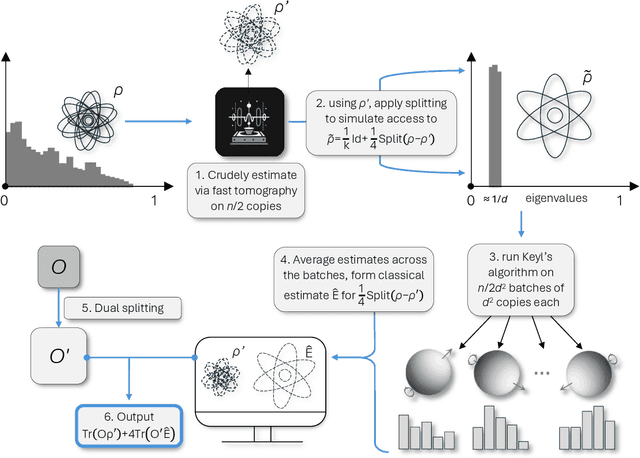
Abstract:We give the first tight sample complexity bounds for shadow tomography and classical shadows in the regime where the target error is below some sufficiently small inverse polynomial in the dimension of the Hilbert space. Formally we give a protocol that, given any $m\in\mathbb{N}$ and $\epsilon \le O(d^{-12})$, measures $O(\log(m)/\epsilon^2)$ copies of an unknown mixed state $\rho\in\mathbb{C}^{d\times d}$ and outputs a classical description of $\rho$ which can then be used to estimate any collection of $m$ observables to within additive accuracy $\epsilon$. Previously, even for the simpler task of shadow tomography -- where the $m$ observables are known in advance -- the best known rates either scaled benignly but suboptimally in all of $m, d, \epsilon$, or scaled optimally in $\epsilon, m$ but had additional polynomial factors in $d$ for general observables. Intriguingly, we also show via dimensionality reduction, that we can rescale $\epsilon$ and $d$ to reduce to the regime where $\epsilon \le O(d^{-1/2})$. Our algorithm draws upon representation-theoretic tools recently developed in the context of full state tomography.
 Add to Chrome
Add to Chrome Add to Firefox
Add to Firefox Add to Edge
Add to Edge